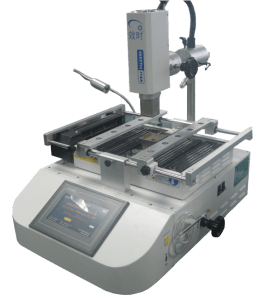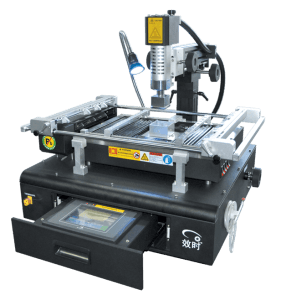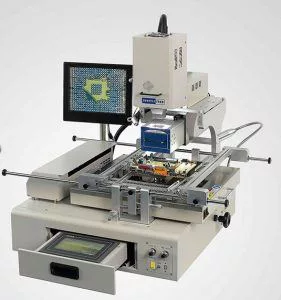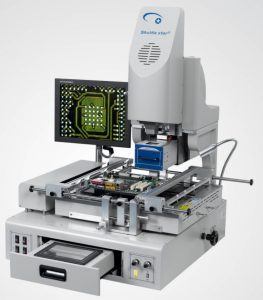Hot Airs vs. IR BGA Rework Stations
Hot air and IR are the two main types of rework stations used by OEMs and PCB contract manufacturers today. Both have advantages and disadvantages and choosing the right one for your application requires careful consideration of a number of factors, including your budget, your working requirements and the capabilities of your staff.
On this page we outline some of the differences between hot air and IR BGA rework stations.
Have a question or need assistance determining which is right for you?
The Precision PCB Services, Inc. team would be happy to help. Give us a call at 888-406-2830 ,or send an email to contact a representative directly.
Hot Air vs. IR Rework Stations: Basic Differences
The main difference between hot air and IR rework stations is the method by which they heat a PCB component. As their respective names imply, hot air stations use heated air whereas IR stations use infrared rays. On a hot air station, a series of differently-sized nozzles guides air circulation and ensures even heat distribution. IR systems, on the other hand, can use a fixed ceramic heater, IR light type heaters or a focused beam. The lower cost machines use a ceramic type heater to radiate the heat. This is not true IR, but that is what the manufacturers advertise it as. Mid-range priced machines use IR light and may use louvers to control the heated area. Both the ceramic heaters and IR with louvers don’t always do a good job of focusing on the heated area. Parts surrounding the BGA may need to be shielded to protect them from heat damage. With the true focused beam IR, you can easily adjust the beam from a small area to a large area. The parts surrounding the BGA are not affected and the beam has a very accurate focus on the area that you choose to heat. One advantage of this type of IR is that you don’t need to purchase different heat nozzles as you do with hot air machines. The drawback is that IR lights and the IR Beam may not heat certain lighter or silver colored parts. You may have to apply a special black tape to get the parts to heat up.
Practical Considerations
The fundamental differences between IR and hot air rework stations have practical implications for technicians. These include:
Noise: Hot air BGA rework stations use a pump to circulate air. While many of today’s best units have pumps that run quiet, all still produce some degree of noise, which can be distracting. IR stations are usually silent.
Speed: The nozzles on a hot air rework station allow technicians to quickly direct airflow towards different components. As a result, the rework process for small, delicate components is often faster — particularly when a skilled technician operates the station.
Maintenance: IR stations have fewer components, which makes them easier to maintain and service as necessary. However, these machines tend to range in consistency — many cheaper stations use low-quality ceramic plates, which may perform less efficiently, or require additional tools and accessories to handle more complex tasks.
Design and Operational Considerations:
The design of the BGA Rework Station along with how the software functions will make a considerable difference in the ability to easily set up a profile and correctly heat the PCB and component so that the board does not warp while at the same time allowing the solder to reflow evenly. When reworking a BGA the concept is to recreate as close as possible the process that was used to assemble the PCB in a closed chamber reflow oven. The best hot air rework stations will have a focused top and bottom heater and an efficient area heater. The top and bottom hot air will allow you to slowly heat the area from the top of the BGA Component to the Bottom of the PCB under the BGA Component to the same temperature. While the area heater will be large enough to bring the overall PCB temperature to 150C to reduce the possibility of warping. The software should allow you the accurately set the temperature of all 3 heaters in degrees, not percent. And most importantly the design should allow for calibration so the heat that the software is set to is the actual temperature that is coming out of the nozzle. Ideally within +10 to -10 degrees minimum variance. An Infrared light type area heater with a black diffuser will allow for even heating of the overall PCB. Other types of hot air designs may use a focused top hot air and a lower board heater without the focused bottom hot air on the component area. The bottom board heater can be a plate heater, a light type Infrared or a plate with holes drilled about one inch apart to allow for hot air to emit.
These 3 types of heating methods all have certain drawbacks. The major drawback is you don’t have the focused hot air under the BGA to assure that the temperature is radiating evenly from the top of the BGA to the Bottom of the PCB. Thus, you may have to adjust the under-heater temperature to a higher temperature without the focused bottom hot air feature. On the plate with holes drilled to allow for hot air to emit. With very small components you may need to mark the exact area that you placed the PCB each time. If the small component is not placed directly above the hole that the air is coming out of, the temperature that the solder is heated may vary. All of the Infrared style BGA Rework Station use an Infrared under - heater without a focused hot air on the bottom side. With all 3 types of these bottom heat only methods, the heat is not always able to be calibrated to be exactly what is set in the software. It can vary as much a 100C on some machines. With some machines you can only set the under-heater temperature in percentage which makes it more difficult to set up accurate profiles. All of these designs will work to some extent. But you will have to spend a lot more time to place thermocouples on the PCB and monitor the temperatures so that you can create a working profile. And you may fry a few chips in the process.
Another design feature to consider is cooling. A system that has an automatic fan cool down is desirable. Fans that will cool down all of the heaters and the PCB are the best. This will allow for a fast cool down so that you can start the next PCB in line for rework quickly. Units that use the drilled holes in the metal plate can take a long time to cool down without external cooling.
Ultimately, whether these factors are a concern will depend on your budget, the size of the PCB’s and BGA’s that you plan to rework and of course the skill of your operators. One of the reasons why hot air rework stations have remained popular is that more technicians were trained on them and know how to use them better. The expense and time of retraining staff to use IR stations can make them prohibitively expensive, particularly in smaller operations.

SP-360C BGA Rework Station

RW-B400C BGA Rework Station

SV550 Split Vision BGA Rework Station
Bottom Line: Which Is Best?
Many hot air and IR BGA rework stations are available today, each of which has a different price point and feature set. This is an older and more established technology — one that we find offers better value for our customers.
Precision PCB Services exclusively sells hot air rework stations that are engineered for maximum performance in demanding applications. We select models for our product line that have all of the top features to allow for fast high yield BGA Rework while a the same time are easy to set up and train operators to use. Keep exploring our website to learn more.
TL;DR IR stations or Infrared Rework Stations are workspace system technicians can use to alter printed circuit boards with ball grid array (BGA) packaging and surface-mounted devices. Hot Air Rework stations are also workspace systems used to alter printed circuit boards with ball grid array (BGA) packaging and surface-mounted devices. The main difference between hot air and IR rework stations is the method by which they heat a PCB component, hot air stations use heated air whereas IR stations use infrared rays.
